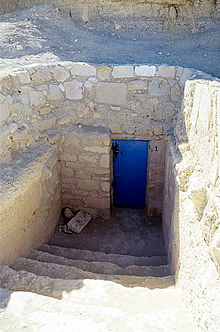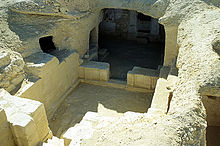 West side of the Gebel el-Mautā | ||
| Gebel el-Mautā · جبل الموتى | ||
| Governorate | Maṭrūḥ | |
|---|---|---|
| height | 50 m | |
| no tourist info on Wikidata: | ||
| location | ||
| ||
Gebel el-Mauta (also Qarat el-Mauta / el-Mawta (the mountain of the dead)) or Gabal / Qarat el-Mauta / el-Mawta el-Musabbarin (Arabic: جبل الموتى المصبرين, Ǧabal al-Mautā al-Muṣabbarīn, „Mountain of the Mummified Dead“) Is an archaeological site in the north of the city Siwa.
background
The graves are located on the flanks of a 50 m high limestone hill with a diameter of about 500 m. The graves date from the 26th ancient Egyptian dynasty to Roman times. Most of the graves are plain and have no features that could be used for dating. The graves lie next to each other on several terraces. They were created both in the side walls and in the floor.
Several graves have long passages carved into the mountain, from which one or more burial chambers branch off. The graves were mostly designed as family or multi-person graves.
Four graves on the middle terrace have a decoration. The decoration is executed as a mixed style of Egyptian and Greek elements. Only the tomb of Per-nj-Pa-Thoth contains purely Egyptian representations.
The burials were based on those in the Nile Valley in terms of coffins and grave goods. The corpses were superficially mummified. The graves were later looted and destroyed. In some cases, this was not done until World War II by the foreign military.
So far there have been no systematic excavations. The most important investigations did not come from until 1941 Ahmed Fakhry (1905–1973).
The British soldiers stationed here around 1940 destroyed parts of the cemetery.
getting there
Follow the asphalt road north out of town in the direction of Marsā Maṭrūḥuntil you get to 1 Branch to Gebel el-Mautā(29 ° 12 '36 "N.25 ° 31 ′ 20 ″ E) headed east.
Tourist Attractions
The four decorated tombs are open to tourists. The site is open from 9 a.m. to 5 p.m. The entrance fees for the Gebel el-Mautā and the temple of el-Wahi are each LE 50, for foreign students LE 25 (as of 11/2019). It is no longer permitted to take photos.
The graves are on the northeast side of the grave hill. It can be reached by walking counterclockwise around the mountain.
Si-Amun's tomb




The tour usually begins with the most important grave in the cemetery, namely the Si-Amun's tomb. Si-Amun is certainly a wealthy local, arguably a trader or caravan driver. But we don't know very much about him, no titles or offices. Only the names of his parents are known. His father is called Periytu, the "protruding one", his mother Nefer-hert, the "beautiful-faced one". He himself has two sons.
However, the tomb was created in high quality by Egyptian artists. But this was only at the time of Wenamun (time of Nectanebo II, 30th Dynasty), the builder of the Amun temple of Umm ʿUbeida, possible, i.e., Si-Amun would be his contemporary.
In the representations we meet the grave lord twice. On the (left) east wall we see the youthful Si-Amun and on the other side the grave lord at an advanced age.
A staircase leads to a door crowned with a hollow, which in turn leads to a narrow grave, at the end of which is the burial chamber. Both side walls are painted on the plaster. But the grave is unfinished. However, the recesses added later for further family burials have partially destroyed the paintings.
The left entrance wall shows a part of the funeral procession in the lower register (picture strip). The mummy is in a shrine on a wheeled cart. You can see it to the left or right of the shrine ba bird, the soul of the deceased, or the god of the dead Upuaut (Wepwawet). The upper register is lost. The procession of the dead continues on the left wall. Here you can see two men pulling the death chariot. There are so-called Mehetwert cows above them.
Further back you can see four scenes in the lower register, which were cut from the later niche openings. First you see the grave lord, behind him a box with instruments for the opening ceremony of the mummified deceased's mouth and his son in panther skin in the role of a priest, holding a staff with a ram's head. In front of the grave lord are the ram-headed Amun and his companion Mut. In addition, Hathor, the goddess of the west - that is the realm of the dead - includes one of the four guardian gods of the bowel jars, Duamutef. The third scene shows the lion-headed god Miysis (also Mihōs, Mahes), son of the goddess Bastet or Sachmet, and the goddess Hathor with a sistrum. In the last scene, the grave lord worships Osiris and Isis.
The right side also has representations in two registers. The upper right shows the deceased as he is held by the goddess Maat, in the court scene in front of Osiris in the shrine and in the presence of 42 gods. Furthermore, four destroyed deities, Re-Harachte and Nephthys, a painted false door and the tomb lord are shown again, but this time seated. The lower register consists of five scenes. On the one hand, this is his younger son in Greek costume, standing in front of the seated grave lord. This is followed by the depiction of the goddess Nut on a sycamore, who offers a water offering in front of the tomb. In the next scene the tomb lord prays the goddess Isis with the so-called. use-Bird and other deities. The penultimate scene shows the grave lord as a mummy in the presence of the god of death Anubis, the protective goddesses Isis and Nechbet and the four sons of Horus who watch over his entrails. The last scene shows the grave lord seated in front of a box with the instruments for the mouth opening ceremony, behind him his older son in leopard skin and his mother.
The ceiling is also decorated. In the front part you can see the goddess Nut, who is surrounded by stars and six sun boats. The middle part is formed by five transverse bands, these are blue, yellow or imitating wood. The rear part consists of winged vultures and falcons and a line of inscriptions from the Book of the Dead in the middle.
Tomb of the Mesoese (Mesu-Isis)
The grave of Tomb of the Mesoese (Mesu-Isis) is about 20 meters further east and has little decoration. The grave lord himself is unknown, one only knows his wife Mesuese (Mesu-Isis). They lived in the fourth to second centuries BC.
The tomb that you enter in the north consists of two chambers and is unfinished. The front sacrificial room is neither plastered nor decorated. The doorway to the burial chamber is designed in the form of a decorated stele: on the left you can see the standing Isis, on the right the seated Osiris. The lintel bears 21 urea each with a solar disk on its head, underneath there are two winged solar disks one below the other.
Tomb of Per-nj-Pa-Thoth


The Tomb of Per-nj-Pa-Thoth (Padhout) is probably the oldest grave in this cemetery. It consists of a courtyard, on each side of which there are three adjacent, inscription-free burial chambers. The irregularly rectangular, 1.8 m wide, 2.2 m deep and 1.8 m high, arched burial chamber of Per-nj-Pa-Thoth adjoins the front.
The grave is decorated with depictions in red that were applied directly to the rock.
In the back is the coffin cut into the floor. Its lid is missing today. There are three important representations in the area of the coffin.
On the left side you can see the grave lord showing four calves of different races on a rope. Next to it begins a hymus to Thoth, which is continued on the back wall. On the back wall you can see the tomb lord in front of the sacrificial table, adoring the enthroned Osiris and the cow-headed Hathor. In the 13-column inscription above the offering table, which began on the left side wall, the grave lord greets Thoth in a hymn (Book of the Dead Chapter 18) and asks him to justify the deceased. Also in the inscription behind Hathor, which begins on the right, the grave lord Osiris asks for his justification. On the right side wall you can see the grave lord with a so-called Sechem scepter, as he offers four boxes with colored fabrics. In addition, the above-mentioned hymn to Osiris begins here, which is continued on the back wall.
Tomb of the crocodile

The Tomb of the crocodile got its name after one of his representations. The grave master himself is unknown. Stylistically, the grave can be dated to the late Ptolemaic (Greek) or early Roman times. The depiction of the crocodile probably indicates a cult around the god Sobek that was carried out at this time.
The tomb consists of three rooms, but only the front one is decorated. The burial chamber is on the left and was originally closed with stones.
There were four headless deities with knives on the door jambs, but they are now lost. On the wall that immediately follows the right door jamb, you can see the enthroned goddess Hathor holding three plant stalks in her right hand and donating a water offering with her left hand. Now comes the name-giving wall: Behind the grave lord is the ram-headed god Amun, who holds a knife in each hand. Below is the crocodile in yellow color. Next to it is a niche under which there is a scene that is now almost destroyed. You can only see the remains of the vine tendril pattern, the two grape-eating foxes are lost. The wall next to the niche shows the tomb before Osiris. Among them were two winged goddesses who protect the god Nefertum on his lotus. Unfortunately, the god Nefertum and one of the two goddesses are also no longer preserved. At the end there are two scenes that show the tomb lord in front of the enthroned Osiris and Isis as well as Horus.
On the left side, before the entrance to the burial chamber, there are scenes in two registers (picture strips). Above you can see the ibis-headed Thoth writing on a blackboard. In front of him is Osiris in a kiosk. The representation in the lower register, in which a woman, perhaps the wife of the tomb lord, worships Osiris and Isis, is also lost today.
More Attractions
From the eastern end of the burial hill one has a good view of the oracle temple of Amun from Aghūrmī.
kitchen
There are restaurants in the nearby town Siwa.
accommodation
Accommodation is available in the nearby town Siwa.
trips
A visit to the Mount of the Dead can be combined with a visit to the temples of Aghūrmī and Umm ʿUbeida connect.
literature
- : Siwa Oasis. Cairo: The American Univ. in Cairo Pr., 1973, The oases of Egypt; 1, ISBN 978-977-424-123-9 (Reprint), pp. 173-206.
- : The Ammoneion: Archeology, History and Cult Practice of the Oracle of Siwa. Mainz: from Zabern, 1988, Archaeological publications; 75, ISBN 978-3-8053-0819-9 , Pp. 48, 83-85, panels 34-41, color panels I-XII.
- : From the oasis of the sun god: the grave of Siamun in Siwa. In:Bol, P [eter] C.; Kaminski, G [abriele]; Maderna, C [aterina] (Ed.): Strangeness - peculiarity: Egypt, Greece and Rome; Exchange and understanding. Munich, 2004, Städel Yearbook; N.F. 19.2004; ISSN 0585-0118, ISBN 978-3-9809701-1-2 , Pp. 363-373.
- : The tomb of Siamun in the Siwa oasis. Wiesbaden: Harrassowitz, 2014, Archaeological publications; 115, ISBN 978-3-447-10239-1 .

